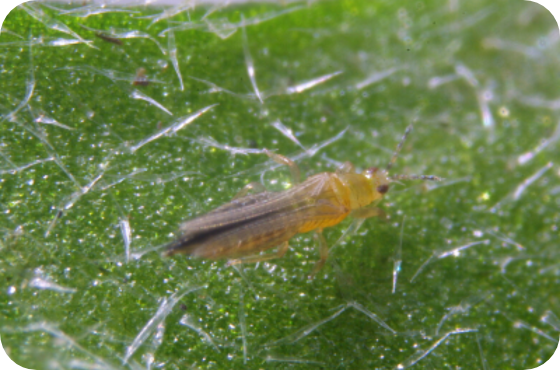Quality Products
Fast Delivery
Premium Service
Written by Jan-Paul de Wit | Last update: 25. January 2023
Thrips, though tiny insects, can cause huge problems in your greenhouse. It is important to understand the possible strategies for thrip control in Canada. In this article, our specialists explain more about thrips and provide insights on thrips control.

It is important to recognize the right type of thrips before you start deciding on thrips control. Flower thrips vary in colour from yellow to dark brown and are often confused with California thrips. However, flower thrips can be distinguished by the absence of long hairs above their compound eyes, unlike California thrips. Flower thrips have eight segments on their antennae and feature long hairs on the top row of their pronotum (neck shield). Their wings also display rows of hair, and their lower bodies are adorned with a comb covered in short hairs. In addition, black thrips, known for their dark color and small size, are a big concern for many growers as well. Therefore, it is important to also consider black thrips control measures.
Thrips are notorious for their damage to both flowers and leaves. They lay eggs on plant surfaces such as leaves, sepals, or petals. These highly mobile pests spread rapidly throughout crops, causing significant harm.
Once hatched, the larvae pierce the leaf surface, leading to cell collapse. This results in a distinctive appearance of silver-grey spots with black flecks. In severe infestations, thrips damage can lead to dehydration of the plant. On peppers, this damage manifests as wart-like deformities.
Beyond physical damage, thrips are also vectors for plant viruses, including the Tomato Spotted Wilt Virus (TSWV). Effective management is crucial to prevent both direct damage and viral transmission.
To tackle thrips infestations, consider using insect netting over air vents as a preventive measure. Implementing detection tools such as sticky traps or rolls can help you keep track of thrips activity. Regular inspections—ideally on a weekly basis—of these traps will provide insights into thrips populations and other pest levels, allowing you to respond immediately to any increases.
Increasing resistance among thrips species to various pesticides, in combination with the loss of approval for many crop protection products, complicates effective management for controlling thrips with chemical treatments. To navigate these issues and find the best chemical solutions for your crops, reach out to our specialist for expert recommendations.
Biological thrips control is becoming more and more popular. Key natural enemies in this method are predatory mites and thrips control insecticides, which effectively target thrips. Discover the right organic thrips control method for your crops:
Pepper grower Thimo van Marrewijk, Het Westland, Naaldwijk experiences:
